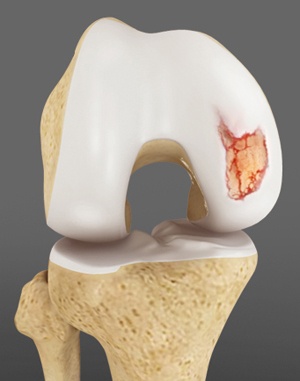
Articular Cartilage
Articular or hyaline cartilage is the tissue lining the surface of the two bones in the knee joint. Cartilage helps the bones move smoothly against each other and can withstand the weight of the body during activities such as running and jumping. Articular cartilage does not have a direct blood supply to it so has little capacity to repair itself. Once the cartilage is torn it will not heal easily and can lead to degeneration of the articular surface, leading to the development of osteoarthritis.
The damage in articular cartilage can affect people of all ages. It can be damaged by trauma such as accidents, mechanical injury such as a fall, or from degenerative joint disease (osteoarthritis) occurring in older people.
What are the treatment options for articular cartilage injury?
Patients with articular cartilage damage experience symptoms such as joint pain, swelling, stiffness, and a decrease in range of motion of the knee. Damaged cartilage needs to be replaced with healthy cartilage and the procedure is known as cartilage replacement. It is a surgical procedure performed to replace the worn out cartilage and is usually performed to treat patients with small areas of cartilage damage usually caused by sports or traumatic injuries. It is not indicated for those patients who have advanced arthritis of the knee.
Cartilage replacement helps relieve pain, restore normal function, and can delay or prevent the onset of arthritis. The goal of cartilage replacement procedures is to stimulate the growth of new hyaline cartilage. Various arthroscopic procedures involved in cartilage replacement include:
- Microfracture
- Drilling
- Abrasion Arthroplasty
- Autologous chondrocyte implantation (ACI)
- Osteochondral Autograft Transplantation
Microfracture: In this method, numerous holes are created in the injured joint surface using a sharp tool. This procedure stimulates a healing response by creating a new blood supply. Blood supply results in the growth of new cartilage.
Drilling: In this method, a drilling instrument is used to create holes in the injured joint surface. Drilling holes creates blood supply and stimulate the growth of new cartilage. Although the method is similar to microfracture, it is less precise and the heat produced during drilling may damage other tissues.
Abrasion Arthroplasty: High-speed metal-like object is used to remove the damaged cartilage. This procedure is performed using an arthroscope.
Osteochondral Autograft Transplantation: Healthy cartilage tissue (graft) is taken from the bone that bears less weight and is transferred to the place of the injured joint. This method is used for smaller cartilage defects.
Osteochondral Allograft Transplantation: A cartilage tissue (graft) is taken from a donor and transplanted to the site of the injury. Allograft technique is recommended if a larger part of cartilage is damaged.
Autologous Chondrocyte Implantation: In this method, a piece of healthy cartilage from another site is removed using the arthroscopic technique and is cultured in a laboratory. Cultured cells from a larger patch which is then implanted in the damaged part by open surgery.
Following the surgery, rehabilitation procedures are advised to necessitate healing and to restore the normal functioning of the joint.
Related Topics
- Patellar Instability
- Multiligament Instability
- Patellofemoral Instability
- Posterolateral Instability
- Knee Arthritis
- Knee Osteoarthritis
- Knee Injury
- Knee Pain
- Anterior Knee Pain
- Meniscal Tears
- Runners Knee
- Jumpers Knee
- Unstable Knee
- Knee Sprain
- MCL Sprains
- ACL Tears
- MCL Tears
- Meniscal Injuries
- PCL Injuries
- Ligament Injuries
- Knee Fracture
- Fractures of the Tibia
- Patella Fracture
- Tibial Shaft Fracture
- Kneecap Bursitis
- Chondral or Articular Cartilage Defects
- Quadriceps Tendon Rupture
- Patellar Tendon Rupture
- Lateral Meniscus Syndrome
- Osteonecrosis of the Knee
- Knee Angular Deformities
- Osteochondral Defect of the Knee
- Articular Cartilage Injury
- Goosefoot Bursitis of the Knee
- Iliotibial Band Syndrome
- Bowed Legs
- Recurrent Patella Dislocation
- Osteochondritis Dissecans of the Knee
- Chondromalacia Patella
- Patellar Tendinitis
- Knee Sports Injuries
- Multiligament Knee Injuries
- Women and ACL Injuries
- Medial Meniscus Syndrome
- Tibial Plateau Fracture
- Tibial Eminence Fractures
- Loose Bodies in the Knee
- Osgood Schlatter Disease
- Patellar Dislocation/Patellofemoral Dislocation








